It’s amazing to see how beautiful and diverse nature is. If you enjoy exploring natural diversity, dedicating some of your valuable time to learning about axolotl color morphs is a worthwhile investment. Moreover, it is important to know these variations if you are going to take care of your axolotl properly.
From classic white and black to vibrant shades of pink, yellow, and orange, axolotl color morphs are a true testament to the beauty of nature. Some axolotls even have unique patterns, such as spots, stripes, or blotches.
In this article, I’ll delve deeper into the world of axolotl color morphs and explore some of the most popular and rare varieties. I’ll also discuss other crucial aspects of these unique pets’ color morphs.
So, no matter how familiar you are with axolotls or how much you appreciate the beauty of the world around you, this piece of writing is sure to captivate your interest. Why not give it a try.
What are Axolotl Color Morphs?
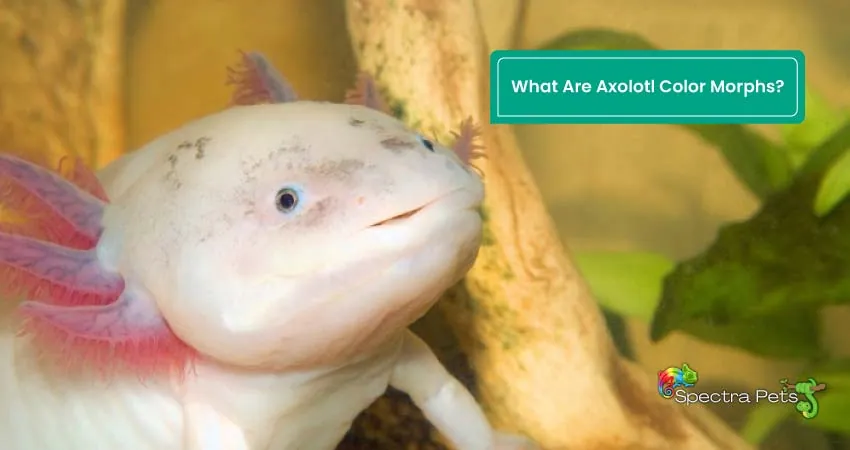
Axolotl color morphs refer to the different variations of color and pattern that can be found in axolotls, which are a type of salamander. Several morphs of axolotl have been developed through selective breeding by enthusiasts and breeders.
Interestingly, each color morph has its own distinctive appearance, ranging from the natural dark brown and gold-flecked “wild type” to the metallic copper or bright yellow “golden” morphs. A number of other color morphs are also common, such as leucistic, albino, melanoid, piebald, etc.
What causes these variations in color and pattern?
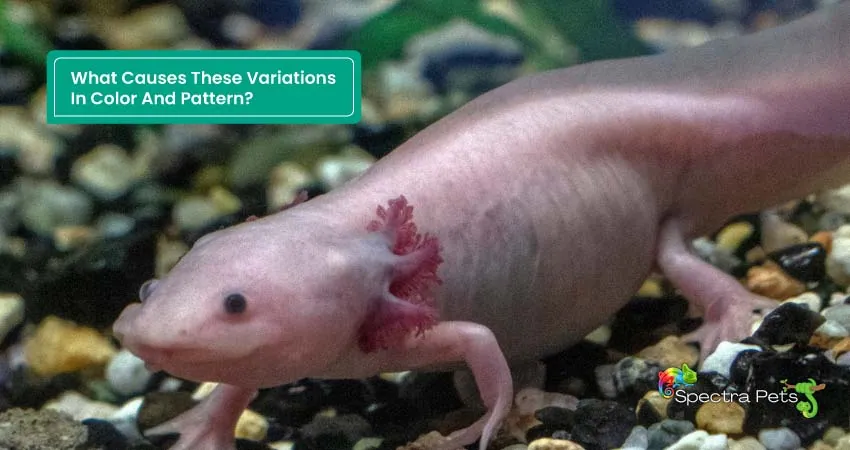
It is mainly their genes that determine the color and pattern of axolotls. In addition to controlling the pigment in their skin, these genes also determine how they look. As a result, some axolotls may have more brown, yellow, or black color than others, and some may have spots, stripes, or other patterns.
Moreover, experts breed axolotls in special ways to get even more cool colors and patterns. They choose the axolotls with the coolest looks and make them have babies together. Eventually, new types of axolotls emerge with unique colors and patterns.
Although the water and temperature that axolotls live in can also affect their color a little bit, genes are the main thing that controls their pigment cells. So, different combinations of these genes can lead to a variety of color morphs.
Read Next: Can Axolotls Change Color?
How Many Types of Axolotls Are Currently Existing?
There are several morphs of axolotls that are currently known to exist. Some of the most commonly recognized morphs include the wild type (normal), leucistic, albino, melanoid, copper, and golden. However, new morphs are still being discovered and created through selective breeding. It’s worth noting that while different morphs may have unique physical characteristics, they are all still the same species – Ambystoma mexicanum.
Therefore, we can say that this magnificent creature has no fixed number of color variations. Regrettably, the presence of Axolotls in their natural habitat is increasingly scarce.
However, as genetic engineering progresses, it’s now possible to create diverse axolotl color variations in the lab. Thus, there are tons of mutant types and morphs out there.
15 Types Of Axolotl Colors and Morphs Explained
In the following table, we’ve gathered 15 different types of Axolotl morphs that will blow your mind. From the funky Leucistic and Golden Albino to the badass Melanoid and Chimera, these morphs bring a whole new level of swag to the Axolotl world. So, let’s have a look…
| Name | Identifying Characteristics/ Appearance | Availability | Price |
|---|---|---|---|
| Enigma | Golden eyes, pale red gills, and a white belly accompany the gray upper body | Rare | $1500 |
| Piebald | Black eyes, red gills, and white body with black patches on the back and face | Rare | $300 |
| Firefly | Combination of GFP albino and wild morphs with dark-glow tails | Rare | $250 |
| Lavender | Dark eye, grayish-red color gills, and silvery light purple body color with gray marks | Rare | $115 |
| Chimera | Both halves resemble two different morphs | Very Rare | Not Sold |
| Mosaic | Speckled with golden, black, and white marks, gills striped in red and purple, and multicolored eyes. | Very Rare | Not Sold |
| Copper | Grayish-red gills, lighter-toned belly, pale gray body adorned with copper-colored freckles | Uncommon | $100 |
| Heavily-Marked Melanoid | Black body with purple-gray, yellow, and light green spots, Black eyes, and purple gills | Uncommon | $75 |
| Green Fluorescent Protein/ GFP | Glowing green eyes, greenish body, and purple or pink gills | Uncommon | $55 |
| Black Melanoid | Deep purple gills, Dark eyes with no shiny golden rings, black body with a purple or gray tummy | Common | $65 |
| Golden Albino | Light yellow gills, yellow, pink, or white eyes, and yellow, peach, pure white, or orange-gold body | Common | $50 |
| Speckled Leucistic | Pink or red gills, white body with few black, brown, and deep green scattered marks here and there, and black or brown eyes | Common | $50 |
| Leucistic | Red or pink gills, black or brown eyes, and gold-flecked translucent white body | Common | $45 |
| White Albino | White or pink eyes, red filaments on gills, and a white see-through body with no spots | Common | $40 |
| Wild | Eyes with golden rings, purple filaments on the gills, and greenish-black or brownish-black body | Common | $40 |
15 Popular Axolotl Morphs: A Brief Guide
It’s time to explore the mesmerizing world of axolotl morphs, with a brief description being provided for each of the 15 different variations. So, prepare to dive into the enchanting realm of axolotl morphs and discover the beauty that lies within these remarkable creatures.
1. Lavender
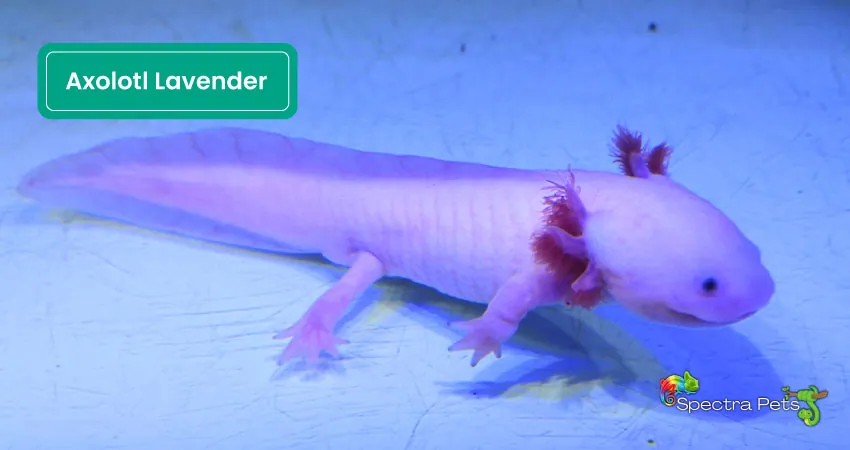
Distinctive Features:
- Silvery light purple body with gray marks
- Attractive grayish-red gills
- Color changes as it matures
The Lavender axolotl morph is a stunning variation that captivates with its unique features. First off, its eyes are dark and mysterious, which gives it a cool vibe.
The body color of the Lavender axolotl is a mesmerizing silvery light purple, adorned with subtle gray marks that add an extra touch of elegance. With grayish-red colored gills, this morph stands out among the other variants of this morph.
However, it exhibits intriguing transformations in color as it matures. While the predominant hue tends to be a captivating shade of purple, certain lavender variants can undergo a metamorphosis, assuming tones of gray or green over time
Moreover, it’s a rare find, which makes it even more special. I mean, who wouldn’t want a unique axolotl like that? But hey, they don’t come cheap. The Lavender morph goes for around $115.
2. Firefly
Distinctive Features of Firefly:
- Their tails contain green fluorescent protein (GFP).
- When exposed to black or UV light, only a portion of their bodies emits a glowing light
- The mastermind behind the creation of this morph is Lloyd Strohl II from Indiana, USA.
- The name “Firefly” stems from their distinctive GFP tails
Firefly axolotl is a unique morph that was artificially created. The mastermind behind the creation of this wonderful morph is Lloyd Strohl II from Indiana, USA. In 2016, he utilized embryonic graphing techniques to develop this special morph
These axolotls have a wild-type appearance with dark coloring, but their tails are distinguished by the presence of green fluorescent protein (GFP), giving them an albino-like appearance. When exposed to black light, only a portion of their bodies will emit a glowing light, similar to the way fireflies illuminate.
By now, you have probably figured out how they came up with this name, right? Their distinctive GFP tails, which fluoresce under black or UV light, contribute to their name, “Firefly.”
Due to their laboratory origins, firefly axolotls are not commonly found or readily available for sale. These axolotls are considered rare in captivity and typically command a price of approximately $250.
3. Piebald
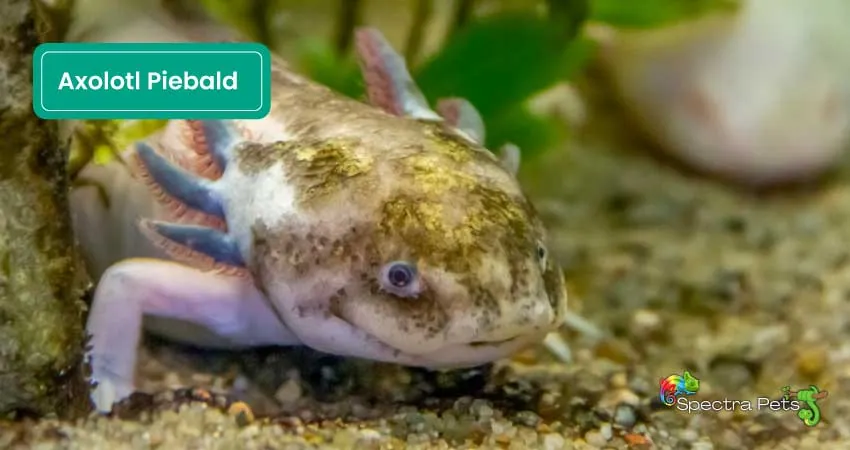
Distinctive Features of Piebald Axolotls:
- White axolotl with red gills, resembling a Leucistic morph.
- Black symmetrical back and face patches, along with black eyes.
- Markings primarily concentrated on the top half of the body.
- Pattern darkens with age
- Exhibits a form of leucistic morph with a high concentration of melanophores on the back and head.
Spotting a piebald axolotl in a sea of axolotls is like a piece of cake. Picture this: a white axolotl with red gills, totally Leucistic vibes, right? But hold up, you can easily identify a piebald axolotl looking at its black symmetrical back and face patches and black eyes. And guess what? Taking care of these axolotl cuties is a breeze, just like with other axolotl morphs.
Now, what makes the piebald axolotl stand out? Well, it’s got thicker and darker black, green, or gray spots compared to other axolotl morphs. Usually, you’ll find those eye-catching markings rockin’ the top half of their body. But piebald axolotls are pretty rare, so they come with a price tag of around $300, which is completely fair. New Zealand is home to the majority of breeders of this morph.
As the axolotl grows older, its pattern becomes darker and may result in a black & white salamander. Overall, the axolotl species exhibits a form of leucistic morph, characterized by a high concentration of melanophores on their backs and heads.
4. Enigma
Distinctive Features of Enigma Axolotls:
- Deep dark gray color with a white belly and legs.
- Catchy golden eyes and pale red gills.
- Golden spots on the body that may appear green from certain angles.
- Rare morph found only in the U.S.A., created by a hobbyist.
- Originates from wild-type axolotls.
The Enigma morph is like a real puzzle piece, with its deep dark gray color, a pretty white belly and legs, catchy golden eyes, and gills in a pale red shade. But what really catches your eye are the golden spots on their bodies. However, from certain angles, these shiny golden patches appear green.
Moreover, Enigma axolotls are pretty rare and you can only find them in the U.S.A because they were created by a hobbyist from there. They originally come from the wild types of axolotl. It’s got a whole bunch of iridophores, special cells that give it a fancy look.
Now, here’s where things get interesting. There’s only one Enigma out there, and not much is known about its genetics or how its special features get passed down. It’s like a big mystery waiting to be solved.
5. Mosaic
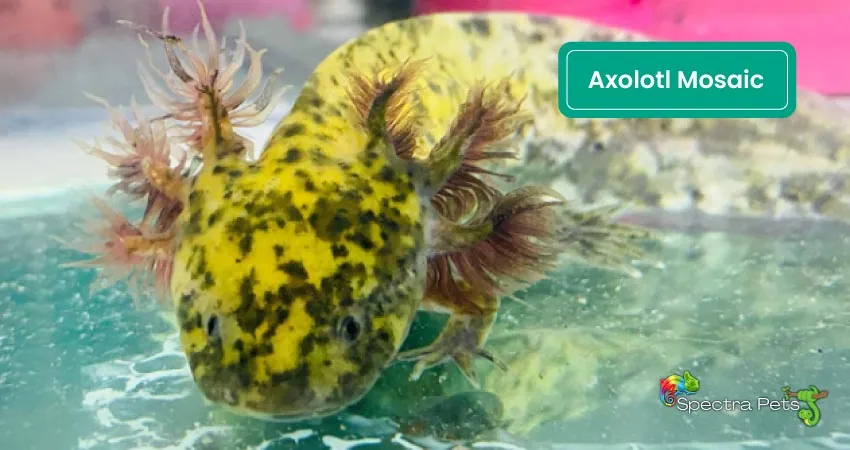
Distinctive Features of Mosaic Axolotls:
- Unique colors in a mosaic-like pattern.
- Speckled body with black, white, and golden flecks.
- Striped gills in vibrant reds and purples.
- Eyes displaying a multitude of colors.
- Result of a mix of melanistic and albino parents.
Mosaic morph axolotls are absolutely stunning with their unique and often dramatic colors, making them incredibly desirable. As their name implies, mosaic axolotls are gorgeous creatures that have a mosaic-like appearance. Their colorful bodies are speckled with black, white, and golden flecks, which create a mesmerizing pattern as they move across the surface.
What makes them even more fascinating is their gills, which are striped in vibrant reds and purples. They have dazzling eyes that display a multitude of colors, making them even more captivating.
The Mosaic morph of axolotls is the result of a mix of melanistic and albino parents. When breeders happen to produce a mosaic axolotl, they usually can’t resist keeping it for themselves or selling it to the highest bidder. So, if you’re hoping to own one of these little beauties, it might be a bit of a challenge.
6. Chimera
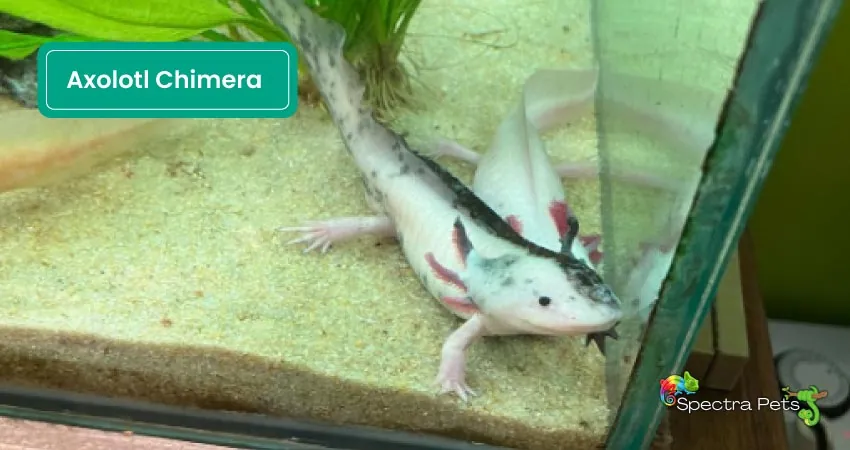
Distinctive Features of Chimera Axolotls:
- Combination of half albino and half wild-type features.
- Chimeras are not selectively bred
- Difficulty in finding and limited availability of Chimera axolotls.
The Chimera is an incredibly rare creature that sparks debates about whether it should be considered a true morph. As you can see, Chimeras have this peculiar trait where one side of their body looks different from the other. It’s like they’re split right down the middle, with a left side and a right side showing distinct features.
What’s amazing is: the few Chimeras that have actually hatched display a fascinating combination of being half albino and half wild-type.
Now, let me tell you the story behind Chimera axolotls. Well, it happens when two developing eggs join and become one. Pretty cool, right? But here’s the catch: most of these fused eggs don’t make it to the hatching stage because they didn’t fully merge together. Maybe that’s why this Axolotol morph is so hard to find.
Oh, and one more thing! Chimeras aren’t something you can breed selectively because they’re not caused by genetics. Nope, they’re just happy accidents in the development process. So, you can’t play matchmaker with Chimeras
7. Green Fluorescent Protein/ GFP

Distinctive Features of GFP Axolotls:
- The presence of green fluorescent protein (GFP) causes them to emit a vibrant green glow.
- Vivid green eyes
- Gills exhibit hues of purple or pink.
GFP Axolotls, known for their striking green fluorescent protein (GFP) that causes them to emit a vibrant green glow, possess unique features that set them apart. These mesmerizing creatures boast dazzling green eyes, a body with shades of green, and gills that exhibit hues of purple or pink.
Moreover, these axolotls have gained popularity in the aquarium trade and as pets due to their unique appearance. They serve as living art pieces, creating a captivating display when placed under ultraviolet light. Due to their rarity and the demand they generate, GFP Axolotls are often priced at around $55 or more, depending on factors such as size and overall health.
However, the genetic trait responsible for the luminous green hue exhibited by this axolotl was originally identified within jellyfish. Subsequently, it was intentionally inserted into the axolotl’s genetic makeup through artificial means.
So, if you desire an exceptionally unparalleled axolotl as a companion, this particular specimen undoubtedly fits the criteria for your ideal pet.
8. Heavily-Marked Melanoid

Distinctive Features of Heavily-Marked Melanoid Axolotls:
- Variation of melanoid axolotls with significant marking.
- Patches of light green and yellow scattered throughout their bodies.
- They have a few subtle, yet distinguishing characteristics that set them apart from standard black melanoid axolotls.
Many people get it all wrong when it comes to melanoid axolotls, assuming they are colorless. But let me set the record straight. It’s true that these cute axolotls don’t have those shiny patches called iridophores, but they do have their own charm.
A variation of melanoid axolotl with a significant amount of marking is called heavily-marked melanoid axolotl. These extraordinary creatures exhibit a black hue adorned with alluring grayish purple markings.
It is worth noting that these color morphs are quite rare, and we do not have much information about them. It’s like they’re keeping secrets or something.
However, what sets apart these captivating beings from their standard black melanoid counterparts are the subtle yet striking patches of light green and yellow scattered throughout their bodies. These distinct characteristics make them easily distinguishable and serve as a testament to their uniqueness.
And guess what? People are willing to pay around 75 bucks to have one of these bad boys.
9. Copper
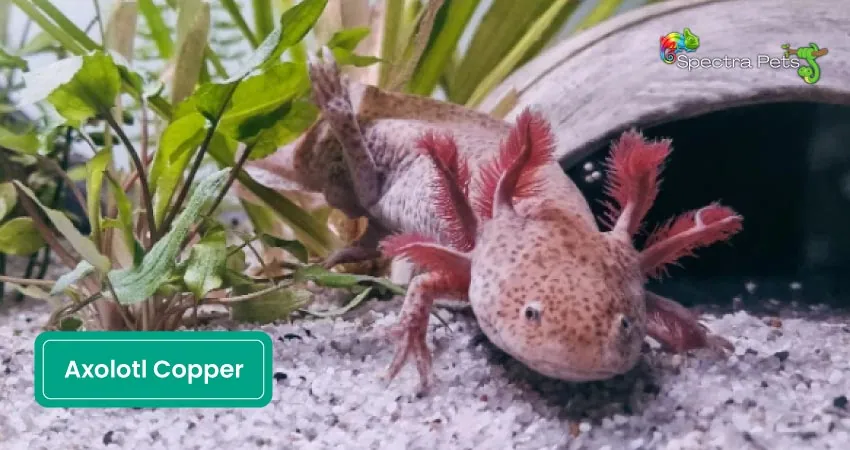
Distinctive Features of Copper Axolotls:
- Delicate gray body with copper-toned flecks.
- Somber gray eyes and gills with a touch of grayish-red.
- Lighter underbellies
- Less intense pigmentation compared to albinism.
These Copper-hued axolotls exhibit a body of delicate gray adorned with copper-toned flecks and eyes of a somber gray shade. Additionally, their gills possess a tinge of grayish-red while their underbellies appear comparatively lighter. Certain copper axolotls showcase a caramel hue, while others verge on an almost pinkish tint.
The endearing countenances of these axolotls, adorned with charming speckles and sandy hues, contribute to the popularity of this particular variant in the regions where they are traded. The initial lineages of copper axolotls trace their origins back to the United States and Australia, making them relatively rarer finds in other countries.
The copper morph is like a less intense version of albinism. They don’t have as much melanin and pteridines, but it’s not like those pigments are completely absent. If you mate coppers with other morphs, you’ll end up with some awesome variations like melanoid and axanthic copper.
10. Wild Axolotls
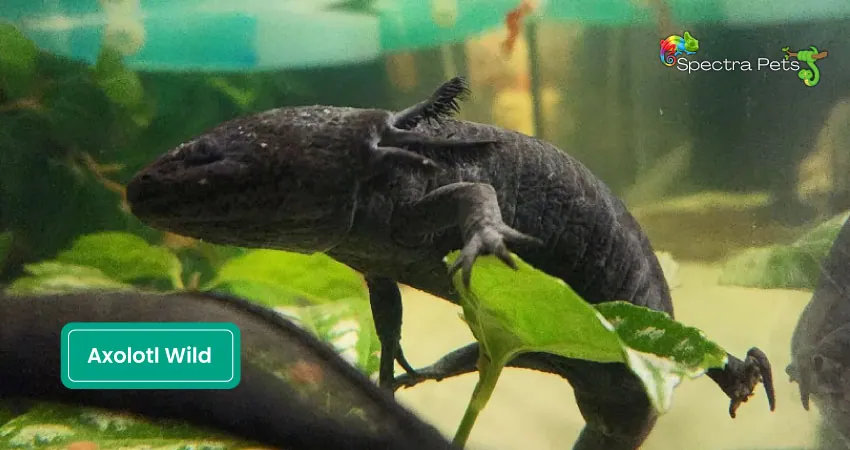
Distinctive Features of Wild Axolotls:
- Darkish shading with golden specks scattered throughout the body.
- Purple gill filaments add an exotic touch.
- Base color is a mix of black, green, and brown for underwater camouflage.
- Shining golden ring around the eyes sets them apart from melanoid axolotls.
True to its name, the wild-type axolotls beautifully imitate the natural appearance of their counterparts dwelling in the muddy lakebeds near Mexico City. Yes, you’ll find this fascinating morph of axolotl in the wild. Back in 1863, the very first wild axolotl species made their way to Europe, marking them as the pioneers of the axolotl pet trade.
This morph got a pretty cool look with darkish shading and golden specks scattered throughout its body. The purple gill filaments make them look exotic.The base color is a mix of black, green, and brown which actually helps these little guys blend in underwater and stay safe from predators.
It is important to note that the wild-type axolotl and the melanoid have a similar dark appearance. However, there’s one key difference. That is, you will see a shining golden ring around the eyes of wild morphs which is absent in melanoid axolotl. Pretty neat, huh?
To get this wild beauty, you need to spend around $40. So, you can easily add this morph to your aquarium.
11. White Albino
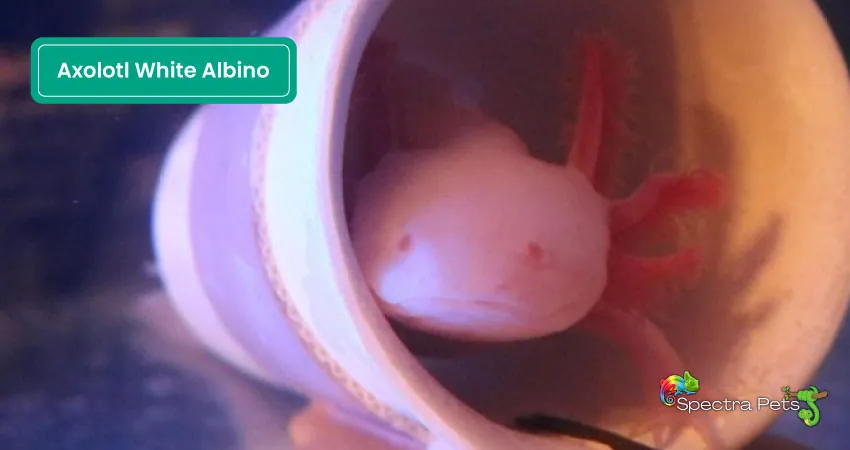
Distinctive Features of White Albino Axolotls:
- Totally white skin with red gills.
- Pink, red, or white eyes, often lacking pigment.
- Young axolotls are almost transparent around their bellies.
- More sensitive to light and have poorer eyesight compared to other axolotl variations.
You’ve probably seen a white albino axolotl before, sometimes just called a white axolotl. These guys are like polar opposites of the black melanoid axolotls in terms of color.
The albino ones have totally white skin with red gills and either pink, red, or white eyes. Sometimes you’ll spot some golden spots around their gill stalks, but otherwise, they’re mostly white.
However, young axolotls are almost transparent around their bellies, especially when they’re still babies. When they grow up, their bellies become less transparent, while the rest of their body remains white, and their gills become darker red.
Because they lack pigment in their eyes, these axolotls don’t have the greatest eyesight and are way more sensitive to light. Despite being a common variation, the white albino axolotl still garners attention and interest from individuals who appreciate the unique beauty and characteristics of these fascinating creatures. It costs around 40$.
12. Leucistic
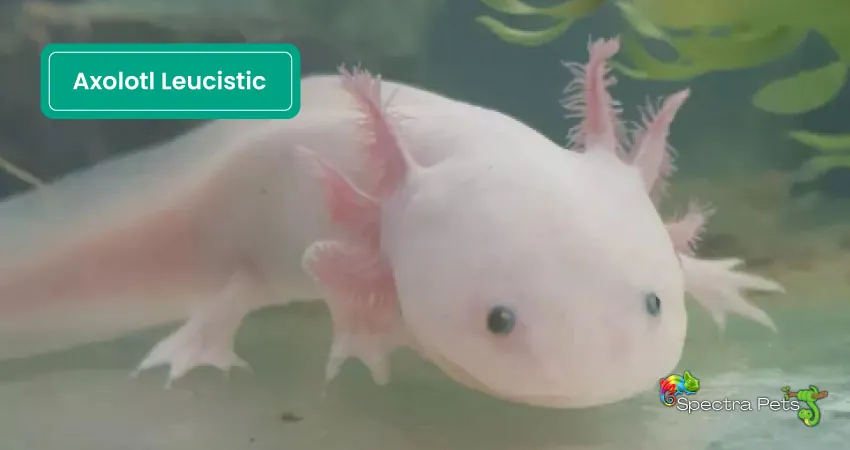
Distinctive Features of Leucistic Axolotls:
- Semi-transparent white or pinkish hue with rosy or pink gills.
- Deep black or brown eyes distinguish them from albino axolotls.
- Popular and widely available in captivity.
- Rarely found in the wild due to their noticeable appearance.
- An affordable choice for collectors.
The leucistic axolotl, or Lucy for short, is way more popular than other morphs of the axolotl. And you know why? It’s all about their astonishing looks and availability. Exhibiting a semi-transparent white or pinkish hue, adorned with rosy or pink gills, and possessing deep black or brown eyes, Lucy stands out in the crowd.
Finding a leucistic axolotl out in the wild is rare. They’re super rare because they stand out like a sore thumb against the darker lakebed. No wonder predators spot them easily! However, the good news is, in captivity, they’re rock stars. People love breeding these axolotls like crazy. Therefore, you can easily add a leucistic morph to your collection.
Now, Leucistic axolotls can easily be mistaken for albino axolotls. But fear not! There’s a trick to tell them apart. Look into their eyes. Leucistic axolotls possess black/ brown eyes, while albinos have pink or white eyes. Oh, and by the way, you can usually snag one of these common morphs for around 45 bucks.
13. Speckled Leucistic
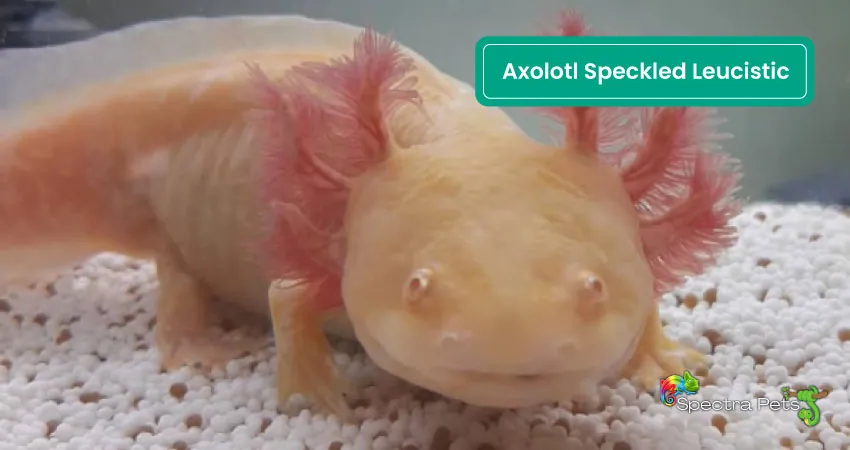
Distinctive Features of Speckled Leucistic Axolotls:
- Intricate patterns of dark green, brown, or black speckles on heads, tails, and dorsal region.
- Milder speckling compared to piebald or mosaic morphs.
- Initially resembling leucistic axolotls, but undergo a captivating transformation as they mature.
- Remarkable alteration in coloration and freckle patterns as pigment cells grow and mature.
Speckled leucistic axolotls represent a distinct variant resulting from a leucistic mutation. These fascinating creatures exhibit intricate patterns of dark green, brown, or black speckles adorning their heads, tails, and dorsal region.
While sharing a fundamental white base color with typical leucistic morphs, the extent of speckling in speckled leucistic axolotls is comparatively milder when compared to the striking patterns observed in piebald or mosaic morphs. As for their price, these axolotls are commonly available and can be acquired for a modest sum of 50 USD.
Remarkably, the appearance of speckled leucistic axolotls initially mirrors that of their leucistic counterparts, only to undergo a remarkable transformation as they mature.
With the growth and maturation of their pigment cells, these axolotls undergo a captivating metamorphosis, resulting in a remarkable alteration in their coloration & freckle patterns.
14. Golden Albino

Distinctive Features of Golden Albino Axolotls:
- Wide color spectrum from white to peach, orange-gold, and yellow.
- Adorned with reflective spots and speckles.
- Colorful eyes in yellow, pink, or white.
- Peachy-hued gills with a lighter shade of yellow.
Golden albinos exhibit a wide spectrum of colors, ranging from nearly pristine white to shades of peach, orange-gold, and yellow. Their bodies are adorned with reflective spots and speckles, accompanied by eyes that can be yellow, pink, or white in color. Moreover, they possess gills with a peachy hue, tinged with a lighter shade of yellow.
These axolotls pose a significant challenge in terms of distinguishing them from albinos during their initial stages as they emerge into the world in a white or translucent form. It is only as they progress through their juvenile phase that their skin begins to emanate vibrant shades of golden, orange, or yellow.
Moreover, in line with other light-colored axolotls in this category, the golden albino morph lacks melanophores, responsible for dark pigmentation. What makes this morph truly distinctive is its retention of xanthophores, which impart a captivating golden-yellow hue.
While their coloration may exhibit various tones, gold prevails as the most prevalent hue. However, their entire body might not be uniformly adorned in this shade. Instead, they might display patches of white, speckles, or even shimmering spots that exude an iridescent allure when exposed to light. This common axolotl morph can be purchased for around $50.
15. Black melanoid
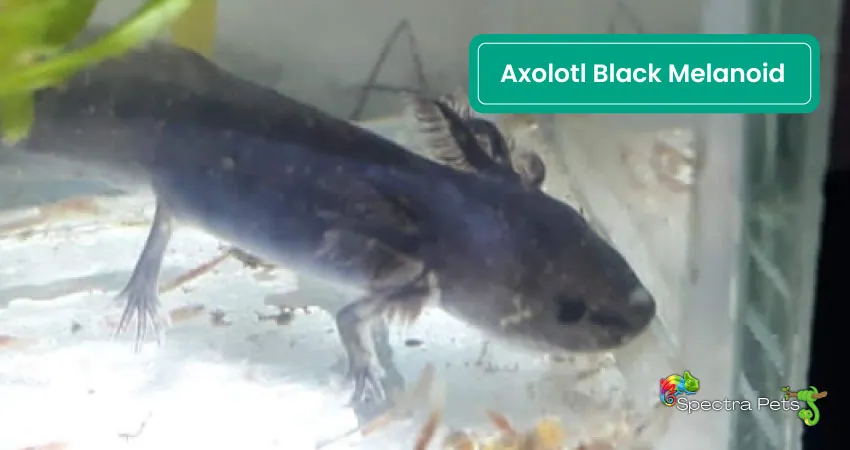
Distinctive Features of Black Melanoid Axolotls:
- Abundance of melanophores and fewer iridophores, giving them a unique appearance.
- Purple-colored gills add to their visual appeal.
- Pale shade on the lower region creates contrast with their dark coloration.
- Lack of golden iris distinguishes them from wild-type axolotls.
Here is the last axolotl color morph. The recessive genetic variation, initially discovered in 1961 within a controlled laboratory environment, has now become quite prevalent. Black Melanoids stand in stark contrast to albinos, exhibiting distinct characteristics. They possess an abundance of melanophores while having a relatively smaller number of iridophores.
Their hues can span a broad spectrum, ranging from dark green to black, accompanied by purple-colored gills. The majority of black melanoids also exhibit a paler shade of gray or purple on their lower region. In spite of the fact that some individuals may resemble the dark wild-type, they lack the radiant golden iris characteristic of wild axolotls.
Notably, black melanoids possess the remarkable ability to modulate their coloration in response to their surrounding substrate. It is crucial to note that this chromatic transformation is not permanent, as your axolotl will adapt its pigmentation to harmonize with any given substrate:
When situated upon a light-colored substrate such as white sand, your axolotl will undergo a lightening effect. Conversely, a dark substrate will induce a profound darkening, resulting in a strikingly black individual. This morph is easily available for $60.
Final words
Alrighty, folks! We’ve dived deep into the wonderful world of axolotl morphs, from the mind-blowing Golden Albino to the jaw-dropping Chimera axolotl. These little critters come in all sorts of flavors, each with its own special charm. It’s no wonder they’re a hit among pet lovers and aquarists.
But hey, let’s not forget our responsibilities as axolotl fans. We gotta promote responsible pet ownership and do our part in conservation efforts.
Before we wrap things up, I wanna know: Which axolotl morph has got your attention? Leave your thoughts in the comments section below, and let’s keep the axolotl love flowing!
